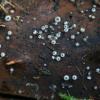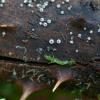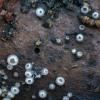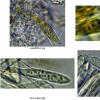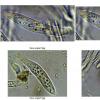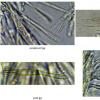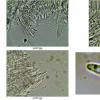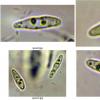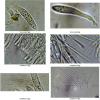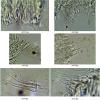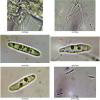
12-11-2025 09:25
 Viktorie Halasu
Viktorie Halasu
Hello, I need help with a pale terrestric Pseudom

11-11-2025 20:16
Bohan JiaHi, lastly I have found these tiny yellow decayin

09-11-2025 13:20
Hello.A tiny ascomycete, appearing as erupting gra

08-11-2025 00:29
 Francois Guay
Francois Guay
I found this species in Quebec, Canada, on herbace

04-11-2025 09:07
Hello.A suspected Hymenoscyphus sprouting on a thi
 Bonsoir à tous,
Bonsoir à tous,J'ai récolté ce que je pense être Urceolella carestiana sur tige pourrie de ronce.
a) asques IKI+, à crochet à la base
b) spores étroitement ellipsoïdes à cylindriques ou fusiformes, guttulées (uniseptées à maturité ?) : 9,5-17x3-4
c) paraphyses filiformes, septées, hyalines, très serrées
d) poils coniques, à parois épaisses, septés, obtus-arrondis au sommet
Qu'en pensez-vous ?
Bernard

Bernard


Have you tested KOH? any changes anywhere?
I have one collection from hardwood, something under "cf. Olla", with fairly similar wide, truly septate hairs. I gave it a nickname "condom-hair", and the hair wall was thin. Here the hair wall is clearly thickened. I need to check the notes/photos. Can't remember by heart.
A very interesting fungus! Thanks Bernard,
Timo

Bernard

Now looking at the sample fresh I can only confirm Bernards photos. The hair apex is solidified, very much like in Olla transiens. Hairs are almost always under 5um wide, so that fits transiens too. Spores are different though, often around 15 um long. Olla transiens spores also vary in lenght, but they are usually under 10um long. ..There are many Olla species in Raitviir's book, not that many with crozier and none with matching sporesize/hair characteristics. Anyway, to me, it has to be an Olla.
Timo

O. transiens is an interesting comparison. But that species does not form such urceolate apos, the hairs are laterally thin-walled and apically partly solidified. Consider also Seppo's opinion to affiliate it in Protounguicularia. I am undecided. Hopy you find out somethin by DNA.
Zotto


